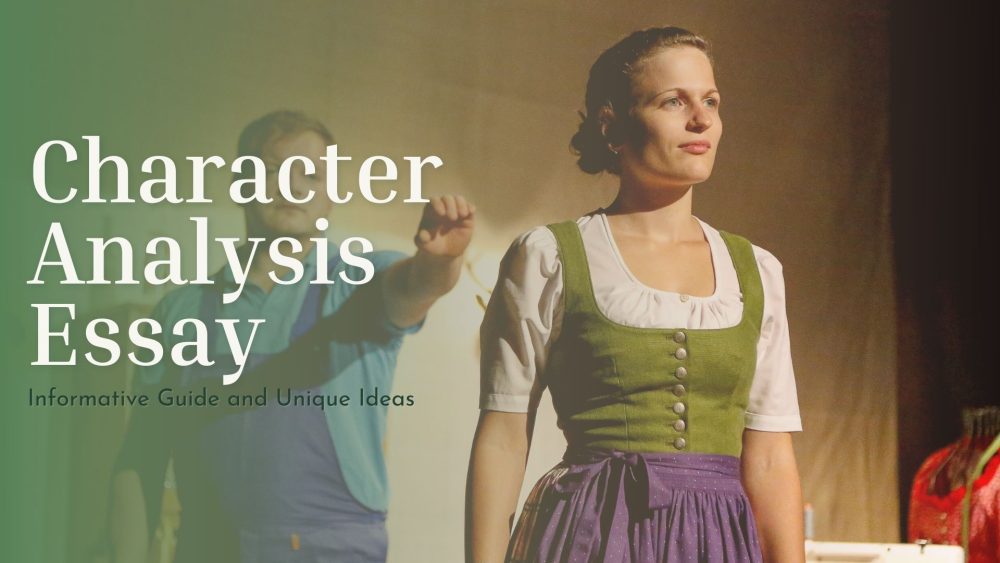Many students find a character analysis essay challenging to write. That’s because the task requires them to study a character from a story or a novel, break them down, and analyze them. Ideally, you select the character to focus on and then stroll through their basic strides. That way, you can come up with a detailed essay that presents their thorough character examination.
What Is Character Analysis?
Many students ask this question when their educators assign them this academic task for the first time. Well, different websites and blogs define character analysis differently. But the general definition is:
Character analysis is a process of examining and highlighting the attributes and qualities of a character in a story.
Your educator can ask you to analyze a character from any artistic work, including a novel and cinematography.
It’s a kind of character study in which you tell the audience who the person is and their role in a story. No matter how strong your inclinations and convictions are, you must use reasoning aptitudes while maintaining objectivity towards the character during the examination process. From this character analysis definition, you must be impartial when examining and explaining the relationships a character has with other players. And this includes their different qualities, how they look and talk.
Here’s an example of a character analysis essay to get an idea of what it is:
Character Analysis Example
Character Analysis: Evolution of Mattie
Mattie is the main character of “True Grit” – a novel by Charles Portis. It is a story of a strong-willed, independent girl living in the 1920s. Mattie’s experience is a demonstration of how internal conflicts affect the formation of one’s self and contribute to personal evolution. The death of her father, as well as the true grit in her character, is what makes the story of Mattie both strained and inspiring. Regardless of being a fourteen-year-old girl, she is a shining example of courage, independence, and spiritual strength.
Mattie’s story is fascinating because of the constant change happening to the girl. It can be traced from several different perspectives. The first one is her relationship with LaBoeuf, whom she found ignorant and hated at the beginning of the story (Portis 47). Later, she opened her heart to him demonstrating kindness. Another storyline pointing to her evolution is courage. At the beginning of the story, she was driven to take vengeance on Tom Chaney for killing her father. But this strive was nothing but a quest, while she was terrified by the sound of shots. However, by the end of the story, nothing could scare her.
Another outstanding Mattie’s quality is independence. Keeping in mind that she lived in the 1920s, her worldview differs from that of ordinary women. She loved the idea of being unique and strong-willed and hated the idea of following a common life pattern – marrying and forgetting about self-development. Mattie could not understand why a woman with a frank tongue and brains is perceived as a leper (Portis 149). All in all, Mattie’s story is a story of true grit – a unique combination of inner strength, courage, invincibility, and perseverance, which made her even more powerful than men, regardless of common mockery regarding her sex and age.
Why Writing a Character Analysis Essay Matters
Perhaps, the question bothering you right now is, “what is the purpose of writing a character analysis paper?” Well, this task does more than helping a learner fulfill a graduation requirement. Writing this essay enables the audience to understand a character and their world.
A fundamental motivation for analyzing or examining a character is to understand their life structures within a story. Ideally, the learner analyzes who a character is in the story’s context. Thus, your educator expects you to reveal exciting details about a character that may have a moral message.
Perhaps, one ideal character analysis example is that of Atticus Finch in To Kill a Mockingbird. Atticus is more than a lawyer because he provides a moral message regarding the essence of doing the right thing even when knowing you can fail.
How to Analyze a Character
Before you analyze a character, ensure that you have read and understood the story. And this means paying keen attention to different situations that a character ends up in, their dialogues with the other players, and the role they play in a plot. Also, gather all information regarding themselves on a larger scale and their influences on the others.
Ideally, think outside the box when reading the story and analyzing a character. That way, you can explore the character’s personality or traits from all angles. Your analysis should be devoid of general statements. Instead, it should explore the details and complexities of the literary work’s character.
How to Write a Character Analysis
To have a profound sense of understanding a character, you must immerse yourself in a literary piece or story. That means taking character notes, understanding the settings and climax of the story. Ideally, take your time to understand all essential academic parts before writing. And this includes seeing and feeling through the character that you want to analyze.
Also, consider how the author shaped the character and brought them to life. Notice how the writer described the character’s identity vastly or undersized. Additionally, consider the character’s behaviors and morals and how they affect other characters and situations in the story. Finally, consider exciting characters in the story.
A Step-by-Step Guide on How to Do a Character Analysis Essay
Your teacher or professor may select the character to analyze and write about while assigning you this academic task. Alternatively, they can allow you to pick your character. In this case, choose a character that plays a dramatic role in a novel or story. That way, your character description will most likely captivate your educator or reader. Here’s how to write your character analysis, step-by-step:
- Read or study the storyEven if you’ve already read a book and know the character you want to analyze, reread it. That way, you’ll explore the explicit scenes where the character appears keenly. Pay keen attention to tiny details of the literary character to understand their traits. For instance, consider the author’s description of a person in their work, their relationships with others, and how their actions propel the plot.
- Take notesUnderline, highlight, or take note of critical elements in the story. Providing specific and vivid examples connects the audience to the character. That way, you bring the character into life in your readers’ eyes. Once you’ve read the story while focusing on the literary work’s person, review the notes to develop the main idea about them. At this point, you can make the first draft using a character analysis essay outline from your educator.
- Select the main ideaWhen reading or studying the story, you will notice an idea that represents your preferred character better. Once you’ve found it, use it to formulate a thesis that you’ll support throughout the essay. Make sure that you have good situations and examples to support your main idea. For example, if you choose Jem Finch in To Kill a Mockingbird as your character, how racial conflicts, internal struggles with public opinions and personal views, and social inequalities shape his character can be your main idea.
- Create character analysis questionsOnce you’ve chosen the main points about the character, come up with questions for filling blanks in your outline. Examples of questions you can ask include:
- What relationships do the character has with other characters in the story?
- Where do most events involving the character occur?
- What’s the background of the character?
- What are the values of your character?
- Who are your character’s friends?
- Create a character analysis outlineCreating an outline for this essay is a critical step that will enable you to organize ideas and thoughts. Therefore, make an overview highlighting the information that will go to your essay’s introduction, body, and conclusion sections.For instance, the introduction should describe the character while sparking interest in the audience. The body should present different areas or ideas about the literary character. For example, answer questions about the physical appearance, background, and personality of the character in the body. Also, tell your readers how the character overcomes different conflicts and what to learn from them.
In conclusion, hold ideas together and make a final statement for the analysis. Here, you can tell the audience how the character’s conflicts compare to those of real life. What’s more, hint at how the character should have reacted better to certain situations. Essentially, your character analysis essay format can compare to other essays, only that you focus on describing their traits and roles in the story.
Sample Character Analysis Topics
Now that you’ve known how to write a character study, you might want to proceed and handle this task. If your educator has not assigned you a topic, consider the following ideas.
- Describe the primary character in A Tale of Two Cities
- Explain The Godfather traits
- Analyze the primary character in Vikings
- Analyze Morgana traits in Merlin
- What are the common characteristics of literary characters in Shakespeare’s work?
- Compare Magical folks and Muggles
- Describe your best static character
- State variations between antagonist and protagonist
- Describe the main character’s role in Daisy Miller
- Explain why Superman has a significant influence on the kinds
- Describe the most irritating character in the best book you’ve ever read
- How do characters in most novels compare to real-life people?
- Describe Holden Caulfield’s wrong sides in The Catcher in the Rye
- Do most authors create characters resembling them?
- Explain the Madame Bovary
- Explain Evalina’s contribution to the story climax
- With an example, explain how the setting affects a character in a story
- Explain how the writer uses metaphors to describe a specific literary character in The Metamorphosis
- Analyze traits that make a character evil- Use examples
- Highlight Charles Dickens’ characters standard features
- How authors create compelling characters- Illustrating with examples
- Why Socrates’ work has so many characters
- How effective has Mark Twain created attractive characters?
- Explain the standard features of characters in Jane Austen’s novel
- Describe the protagonist in A Clockwork Orange
- Analysis of the main character in The Sorrows of Young Werther
- Describe the struggles that motivate a character in an epic poem
- How Gilgamesh organization contributes to the main character’s development
- Compare the main characters in Buffy Summers and Harry Potter
- Describe the essential feature of Othello as a character
- How Charles Dickens criticizes public policy through Oliver Twist’s description
- What can you say about Jay Gatsby?
- Why is King Arthur so famous?
- With examples, explain how flashback brings out the traits of a character
- With a character as your example, explain how a TV series brings out the friendship concept
- Explain how Mrs. Malfoy changes into a good person
- Evaluate Hermione Granger’s qualities as a heroine
- Why Frida Kahio is so attractive in the literary world
- Describe the character traits of Madame Bovary
- With examples, explain how evil characters affect the audiences
Even when you know how to write a character study and have sample topics, you may have difficulties completing your task. That’s because you might lack adequate time to study the literary work and analyze your preferred character. However, this shouldn’t hinder you from scoring the top grade. Instead, seek affordable writing help from experts with a good reputation for helping college students with their essays. That way, you’ll complete this task without breaking a sweat









